International rocket mail KI Rambella (USA)
The future inventor of rocket mail, KI Rambel was born in 1920 year in the small town of McAllen (pc. Texas), located near the Mexican border. In 1936, he had to finish school, after which he planned to enroll in one of the local universities. Curious is the fact that he had to take up design work before he received higher education and - formally - before graduation. One of the reasons for this was the difficult economic situation in the country.
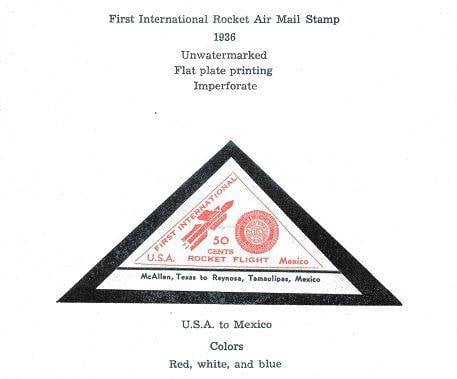
Mark vignette for letters sent on July 2 1936 from the USA to Mexico. Photo of Flyingcarsandfoodpills.com
In the mid-thirties, the Great Depression began to decline, but the situation in the United States remained unsatisfactory, especially in the provinces. The post office of McAllen, where Father K. Rambel worked, was in poor condition and was no longer subject to repair - it required the construction of a new building. But the organization could not afford such luxury, and therefore was forced to work in an emergency building. Fortunately, the father and son Rambla found a way out of this situation, and the most interesting and original one.
Enthusiasts could not know about the February experiments on Lake Greenwood and decided to repeat them. Sale of stamps and envelopes for sending letters by rocket mail made it possible to raise money for the construction of a new building. In addition, the mailing rocket could solve the characteristic problem of the border town by sharply accelerating the shipment of international shipments.
In 1926, a new bridge was built over the r. Rio Grande, which now passed the road from the American McAllen to the Mexican city of Reynosa (pc. Tamaulipas). This road was used to transport mail, but due to bureaucratic delays and other factors, letters went through it for several days. Cargo rocket could significantly speed up the transportation of correspondence across the border, as well as simplify customs clearance.
The author of the idea and the initiator of further work was Keith Rambel. Father and his colleagues volunteered to help in one way or another. For obvious reasons, enthusiasts had a limited choice of materials and technologies, but this did not prevent them from fulfilling all their plans and even bringing rocket mail to the test.
Design
The transport rocket K. Rambela was distinguished by its extreme simplicity of design and was made exclusively from available materials. However, some components had to be purchased and delivered from other cities. First of all, it concerned the powder engine. However, even with such a specific appearance, the rocket, as a whole, could solve the set tasks.
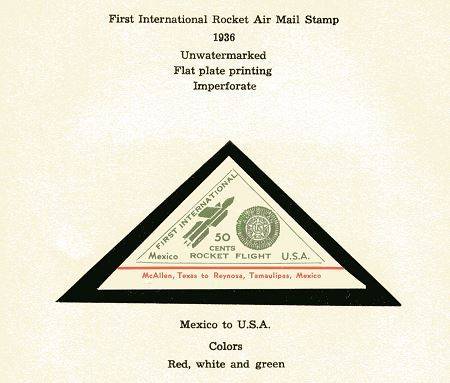
Vignette for letters from Mexico. Photo of Flyingcarsandfoodpills.com
The missile received a simple cylindrical metal body with a conical head fairing. Several tail planes were placed on the tail. The head compartment of the hull stood out for the placement of cargo. Another volume for letters was directly in front of the engine. This separation of the cargo compartment allowed for optimal balancing. In the back of the product was ready powder engine with its own metal body. The rocket had no means of control and had to fly along a ballistic trajectory in accordance with the angles of guidance at launch. Whether there was a parachute on board for a safe landing was unknown.
For the rocket intended launcher simple design. Its main elements were inclined guides for putting the rocket on the calculated trajectory. The launcher was not equipped with engine ignition means. Fuse, responsible for starting the engine, would have to ignite manually.
Rocket K. Rambela had a length of about 7 feet (2,1 m) and a diameter of 1 foot (0,3 m). The mass of the product is a few kilograms. Up to 300 letters or postcards could be placed in the head compartment, depending on the size and weight of each such “element” of the payload. The product did not differ in long flight range, but no special requirements were imposed on it. The width of the Rio Grande River at the site of the proposed launch did not exceed 300 m, and this determined the desired rocket parameters.
Prepare
22 June 1936 of the year on one of the sites near their city K. Rambel and his colleagues made three test launch of mail missiles. The products carried a different load - from 82 to 202 letters with a total weight from 3 to 10 ounces (85-290 g). With all the flaws in the design of the rocket, the tests were completed successfully. The possibility of transporting correspondence has been confirmed in practice.
At the very beginning of July, the 1936 of the year brought a launcher and several missiles from the American side to the shore of the Rio Grande. Having agreed with the Mexican side, the rocket enthusiasts sent a set of necessary items to Reynosa. It was assumed that on the day of launch, several mailing missiles would depart from the United States for Mexico, and then fly in the opposite direction. On board the missiles were supposed to be real letters sent from two countries to neighboring states.
For future launches, two versions of the “International Rocket Mail” brand were printed. Both postage signs had a similar design, but differed in colors that corresponded to the national flags of the countries of departure. Thus, the “American” stamp had a triangular shape and was printed on white paper in red and blue colors, while the “Mexican” stamp had a green and red print. The rest of the brand did not differ from each other. They had images of a flying rocket and explanatory inscriptions. Brand value - 50 American cents.
Informal stamps-vignettes were issued in the form of blocks, which, if necessary, could be cut into separate signs of payment. At the same time, for a block of four brands, the organizers asked for the 3 dollar.
However, such stamps were not official and from the point of view of the postal legislation they were merely souvenirs. In connection with this, letters were also franked by the official stamps of the airmail of the United States and Mexico. Letters from McAllen had a stamp worth 16 cents, from Reynosa 40 centavos.
Flying
The rocket launches required to collect construction money were scheduled for July 2 of the year. On this day, spectators gathered on both banks of the Rio Grande. In addition, the event was attended by representatives of local authorities of the two countries. After the speeches on the development of communications and modern technologies, the first start took place.
The first Rambela rocket was able to turn on the engine, get off the track and go to the other side of the river. However, about 100 feet from the launch site (about 30 m), already above the river, an explosion occurred. The rocket scattered burning letters over the water, and in addition, some fragments flew in the direction of the audience. One of the customs representatives was injured in the arm. Some time had to be spent on eliminating the consequences of the explosion; first of all, on the search and collection of scattered letters. The survivors of the explosion sent later sent to Mexico by land transport.
July 2 and the second start. The new rocket proved to be much better than the first. The flight path was too high, because of what the rocket flew over the Rio Grande, and then headed for Reynosa. The product fell almost in the center of the city, where it was picked up by employees of the Mexican post office. Fortunately, no one was injured when the rocket fell, and all the witnesses got off with only a slight fright.
The third launch of the mail rocket ended with similar results. Having flown across the river, the rocket fell on a residential building on the outskirts of the city. The dwelling was damaged, but no one was hurt. The payload of the rocket did not receive any special damage.
After three launches from the USA to Mexico, enthusiasts and their patrons crossed the river across the bridge to make new launches in the opposite direction. According to various sources, five or six missiles were sent from Reynosa to McAllen with mail. Almost all launches were satisfactory. The rockets flew across the river and fell in a deserted area where they could not hurt anyone. However, it was not without trouble. The last of the launched rockets landed in a cornfield and set fire to vegetation. The authors and patrons of the project had to urgently return to the United States and take part in extinguishing the fire.
As a result, 2 July 1936, Kit I. Rambel, his colleagues and government officials of the two countries conducted seven or eight launches of a mail rocket, and immediately on the "international line". Flying and falling, as well as explosions and fires survived about 2 thousand envelopes with unique stamps. After the completion of the launches, all the collected letters were transferred to the respective post offices in Mexico and the USA, after which they went to their addressees.
Results
It is known that the sale of their own vignettes allowed KI Ramboel and his comrades raise enough money to start building a new post office building. Thus, the initiative project of rocket mail completely coped with its main task. His further fate, however, was in doubt. As it became known later, enthusiasts from McAllen were not going to develop interesting ideas and introduce them into mass exploitation.
Such a decision is completely understandable and logical. Despite the obvious gains in the time of shipment of mail from the United States to Mexico or vice versa, rocket mail had a number of serious flaws. So, there was a high risk of losing a missile with a payload in flight or during a hard landing. Also, the first three launches from the USA showed what the deviation from the desired trajectory could lead to. All this meant that, before full-fledged operation, the project of C. Rambela needed the most serious processing, which could hardly be considered expedient.
In addition, in the fall of 1936, the project was left without its creator. 16-year-old Keith Rambel enrolled at Rice University after graduation. About a year later, the university sent him to study at the Massachusetts Institute of Technology. The student showed great interest in rocket technology and repeatedly conducted various experiments, but he no longer intended to launch postal missiles through the Rio Grande.
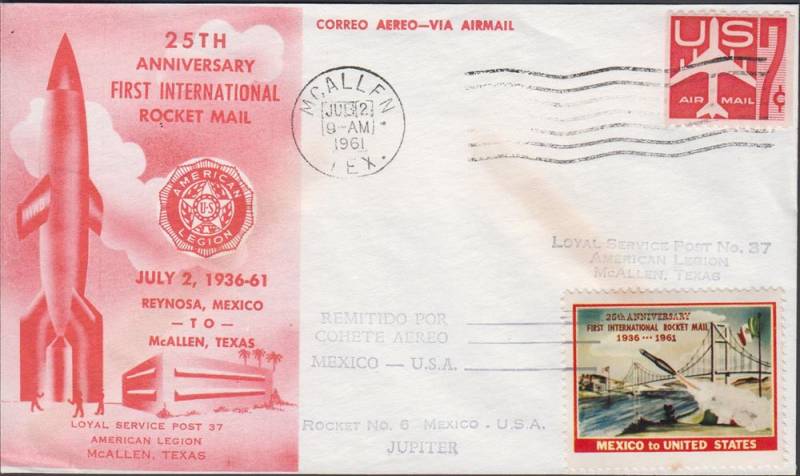
The envelope and stamp dedicated to the XI anniversary of the KI launches. Rambela Photo Jf-stamps.dk
Thanks to the work of C. Rambel and his colleagues, the philatelic community received a significant number of collection materials. About 2 thousand envelopes with stamps made a real flight on a rocket; some more vignettes were not lifted into the air, but were also of interest to the interested public. The signs of the “first international rocket mail” are still found on the corresponding trading floors.
Memory
30 June 1961 of the year on the border of the United States and Mexico held festive events dedicated to the 25 anniversary of the launch of mail missiles. The main event of the holiday was the launch of new rockets from both banks of the river. Of the cities of McAllen and Reynosa launched six missiles with new envelopes. The development of rocket technology allowed to paint the exhaust engines in the colors of the national flags of the two countries.
On special anniversary envelopes there was a drawing of the rocket K. Rambel and corresponding inscriptions. Immediately after the flight, these materials went on sale and soon took their places in the collections.
Five years later, on the shores of the Rio Grande, 30 celebrated its 1936 launch of the year. The round date was marked by a large number of rockets and an increased number of philatelic materials. As far as we know, in 1966, both new envelopes and stamps and materials left over from the previous holiday were on board the missiles. In their case, overprints of the original drawing were made with a new date and other information.
For the United States, the 1936 of the year, rocket mail was an interesting novelty. Among other things, this is why every new project of this kind could be the first in a particular area. So, R. Kessler's experiments were the first in the country, and K.I. Ramblel organized the first international mail forwarding using rockets. All these projects were too bold for their time, and therefore did not receive development. However, they occupied an important place in stories rocketry and mail.
On the materials of the sites:
http://flyingcarsandfoodpills.com/
http://epizodsspace.airbase.ru/
http://collectspace.com/
http://hipstamp.com
http://thestampforum.boards.net/
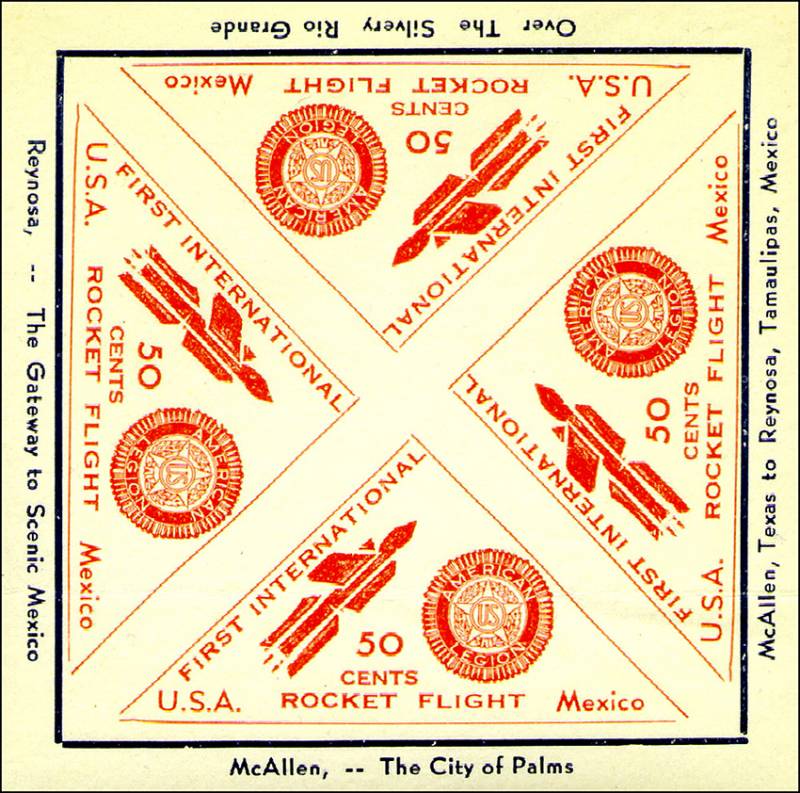
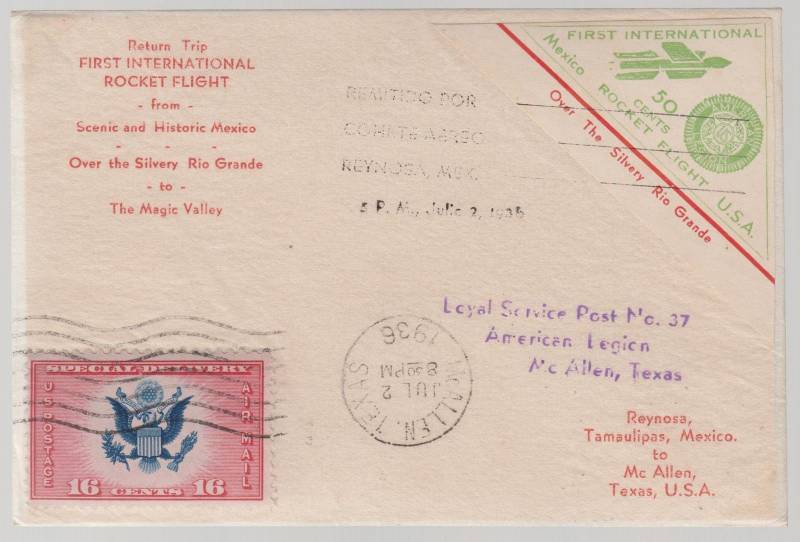
Information